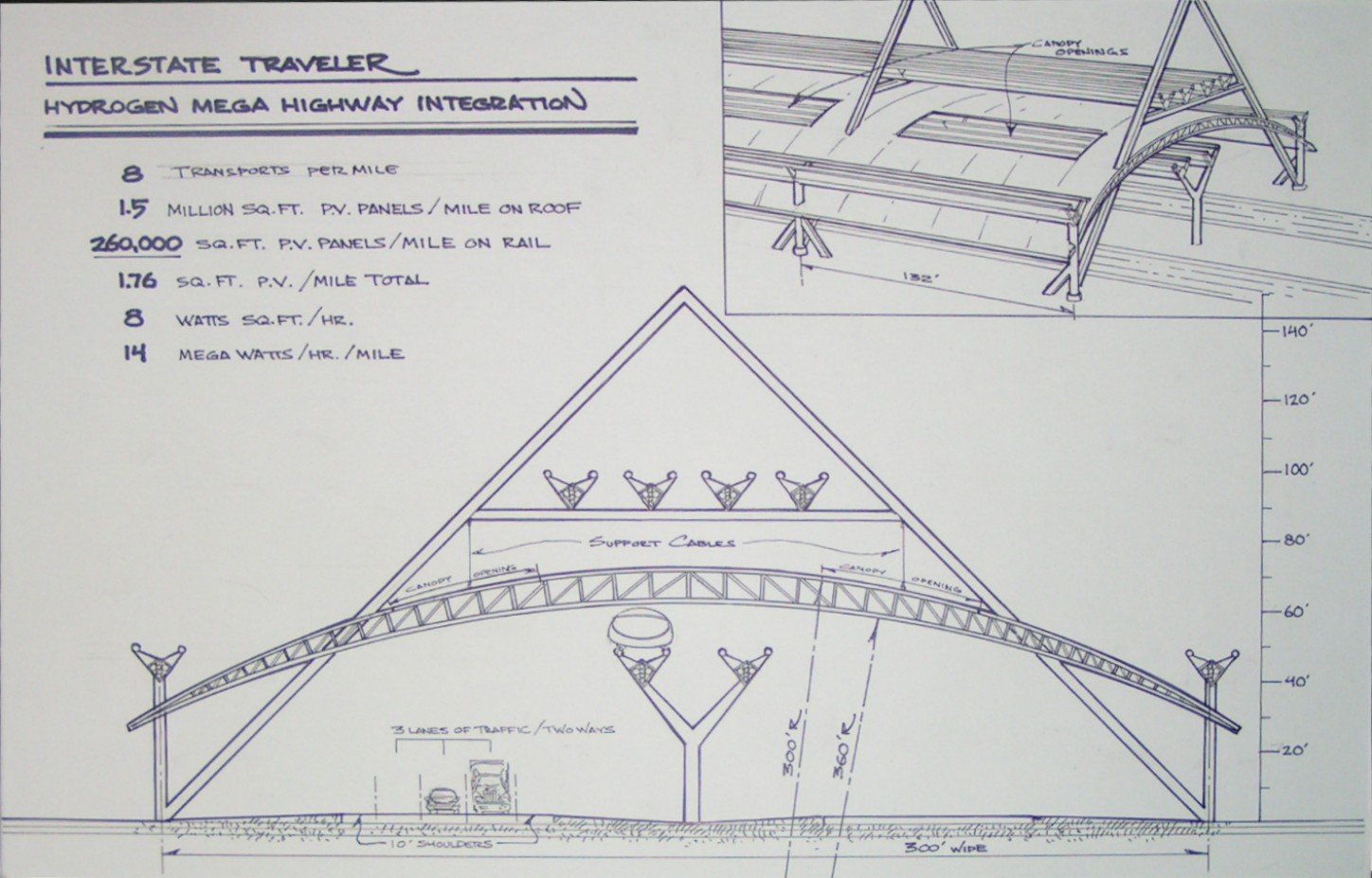
The Interstate Traveler Hydrogen Mega Highway system includes the integration of a series of isosceles triangle structures built every 132 feet supporting a continuous arch form canopy structure that will comprise approximately 1.7 million square feet of roof area. The series of isosceles triangle structures will also support at least four additional lanes of Interstate Traveler Rail traffic at it's apex.
The actual square feet of roof area per mile as shown to scale below is 325 feet in width times 5,280 in length creating an actual square feet of 1,716,000.
As a part of the environmental stability of the system, 200,000 square feet will be left open for ambient light and for the movement of air. The remaining 1.5 million square feet will be used for windowed sections of opaque or partially transparent solar panel material. Each windowed section of the canopy will be enabled to open under a specified amount of air pressure to mitigate aerodynamic lift generation by perpendicular winds.
Now, we have established that the canopy will support an approximate 1.5 million square feet of solar panel material per mile. Assuming a minimum of 10 watts / square feet on average, the Hydrogen Mega Highway canopy structure should yield about 15 Megawatts per mile per hour. Counting 8 hours in a solar day, that is a total of 120 megawatts per day adding up to 43,800 Megawatts per year. The projected value of this electricity at $0.10 USD per kilowatt is $4,300,000.00 USD per year per mile.
The additional square footage of solar panels supported by the additional four lanes of rail mounted at the apex of the HMH will provide no less than 160,000 additional square feet of solar panel material to increase the above electrical output by 1.6 megawatts per hour per mile.
In the illustration shown below, there is a total of eight lanes of traffic for the Interstate Traveler. With a theoretical average capacity of 3 cars per mile per lane, we can project a capacity of 24 Traveler Transports per mile. If each Transport has a capacity of 100 Travelers, we can project a capacity of 2,400 Travelers per mile. With eight lanes of traffic there is a theoretical maximum capacity of 52 Transports per lane or 416 Transports per mile yielding a theoretical maximum capacity of 41,600 Travelers per mile.
Fare box revenue at average capacity, assuming each traveler traverses one mile in 30 seconds (120mph), that is 1,200 minutes of billable service at $0.05 per minute for a revenue of $60.00 per minute or $3,600.00 per hour. If we project 4 hours per day of full capacity, we can project $5.2 Million per mile per year revenue.
Combined revenue of electrical power and fare box collections add up to $9.5 Million per mile per year. If the average city had 20 miles of the HMH covering their most heavily used segments of highway, the projection of $190 Million per year revenue at theoretical average.
Rainwater collection has been estimated from 15,000 gallons up to 150,000 per hour per mile during a 1 inch rainfall depending on which rain gage standard is employed. Until we have exact numbers we will leave this as estimated above. However, as a base measure, there is 36 Million square inches of surface area per mile of canopy. If a water column of one inch in height that is one inch square is created by natural rainfall in one hour, the total water collection would be 36 million cubic inches. One US Gallon is about 231 cubic inches projecting the collection of 155,844 gallons per mile per hour.
Most importantly, it is critical that we recognize that a traditional eight lane express way has a theoretical capacity of 2,112 cars per mile at 20 lineal feet per car during "bumper to bumper" traffic. Therefore, the application of the Interstate Traveler Hydrogen Mega Highway in high density traffic corridors will enable a full 100% increase in Traveler capacity over and above the traditional highway capacity using automobiles with only one passenger per car.
